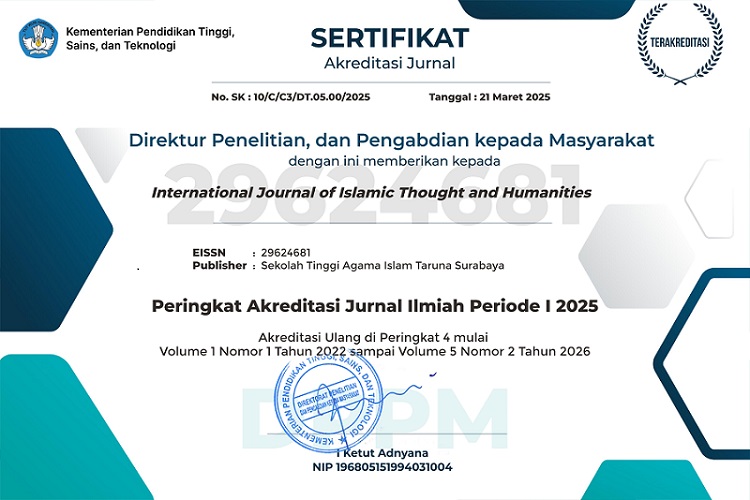Nahdlatul Ulama’s Domination in Madura: An Eco-Anthropological Perspective
DOI:
https://doi.org/10.54298/ijith.v3i1.180Keywords:
ecological anthropology, Muslim population in Madura, Nahdlatul UlamaAbstract
On the basis of the ecological anthropology perspective, this study analyzes the complex relations between the environmental environment and the Muslim population in Madura so that traditionalism Islam dominates their religious culture in the Nahdlatul Ulama model. This study reveals that Islamization history in Madura, kiasi's social, religious role, and Syaichona Kholil’s figure became the three main lead factors that drive traditional religious culture in Madura, especially in Bangkalan. Two of the three factors mentioned earlier are closely related to the geographical location and ecological condition of Bangkalan.
Downloads
References
Abdurachman. (1997). NU: Islam Tradisional dan Modernitas di Indonesia. Jurnal Studia Islamica, 4 (4).
_____. (1988). Sejarah Madura: Selayang Pandang. Sumenep: Offset Matahari.
Azra, Azyumardi. (1994). Jaringan Ulama’: Timur Tengah dan Kepulauan NusantaraAbad XVII dan XVIII. Bandung: Mizan.
Badan Pusat Statistik Kabupaten Bangkalan. (2023). Bangkalan dalam Angka 2023 Bangkalan: BPS Bangkalan.
Bizawie, Zainul Milal. (2016). Materpeace Islam Nusantara: Sanad dan Jejaring Ulama Santri (1830-1945). Tangerang: Pustaka Compass.
De Graaf, H. J. & Pigeaue, TH. G. TH. (1989). Kerajaan-kerajaan Islam di Madura: Peralihan dari Majapahit ke Mataram. Jakarta: PT. Pustaka Utama Grafiti.
Febrianto, Adri. (2016). Antropologi Ekologi: Suatu Pengantar. Jakarta: Kencana.
Geertz, Clifford. (1983). Agama Jawa: Abangan, Santri, Priyayi dalam Kebudayaan Jawa. Jakarta: Pustaka Jaya.
Haryanto, S. (2017). Pendekatan Historis dalam Studi Islam. Manarul Qur’an: Jurnal Ilmiah Studi Islam, 17(1), 127–135.
Hornby, A.S. (2000). Oxford Advanced: Dictionary of Current English. UK: Oxford University Press.
Jainuri, Achmad. (2004). Orientasi Ideologi Gerakan Islam: Konservatisme, Fundamentalisme, Sekularisme, dan Modernisme. Surabaya: Lembaga Pengkajian Agama dan Masyarakat [LPAM].
Kontowijoyo. (2017). Perubahan Sosial dalam Masyarakat Agraris Madura (1850-1940). Yogyakarta: Mata Bangsa.
Mulkhan, Abdul Munir (2020). Makrifat Burung Surga dan Ilmu Kesempurnaan Syekh Siti Jenar. Yogyakarta: Kreasi Wacana.
Nata, Abdullah. (2001). Peta Keberagaman Pemikiran Islam di Indonesia, (Jakarta: Raja Grafindo Persada.
Pribadi, Yanwar. (2013). Religious Network in Madura: Pesantren, Nahdlatul Ulama, and Kiai as the Core of Santri Culture in Al-Jāmi‘ah, 51 (1).
Rahman, Saiful. (1999). Biografi dan Karomah Kiai Kholil Bangkalan: Surat Kepada Anjing Hitam. Jakarta: Pustaka Ciganjur.
Ricklefs, M. C. (2013). Mengislamkan Jawa: Sejarah Islamisasi di Jawa dan Penentangnya dari 1930 sampai Sekarang. Jakarta: Serambi Ilmu Semesta,
Rozaki, Abdur. (2013). Menabur Kharisma Manuai Kuasa: Kiprah Kiai dan Blater Sebagai Rezim Kembar di Madura (Yogyakarta: Pustaka Marwa).
Shepard, William S. (1987). Islam and Ideology in International Journal of Middle East Studies, 19 (3), 318.
Sunyoto, Agus. (2017). Atlas Wali Songo. Depok: Pustaka IIMaN.
Downloads
Published
How to Cite
Issue
Section
License
Copyright (c) 2024 Vicky Izza El Rahma, Nasiri Nasiri

This work is licensed under a Creative Commons Attribution-ShareAlike 4.0 International License.
Authors who publish with this journal agree to the following terms:
- Authors retain copyright and grant the journal right of first publication with the work simultaneously licensed under a Creative Commons Attribution-ShareAlike 4.0 that allows others to share the work with an acknowledgement of the work's authorship and initial publication in this journal.
- Authors are able to enter into separate, additional contractual arrangements for the non-exclusive distribution of the journal's published version of the work (e.g., post it to an institutional repository or publish it in a book), with an acknowledgement of its initial publication in this journal.
- Authors are permitted and encouraged to post their work online (e.g., in institutional repositories or on their website) prior to and during the submission process, as it can lead to productive exchanges, as well as earlier and greater citation of published work (See The Effect of Open Access).


















